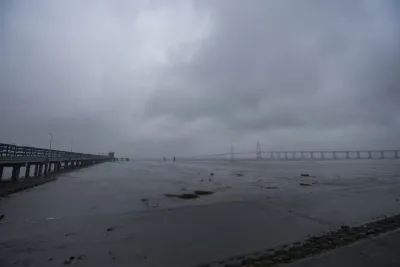What is the Impact of Typhoon Fengshen on China?

Synopsis
Key Takeaways
- Typhoon Fengshen has been upgraded to a blue alert status.
- The storm is expected to bring strong winds and heavy rain to southern China.
- It will move northwest before heading southwest towards Vietnam.
- Areas including Zhejiang and Fujian will be affected.
- Vietnam deals with the aftermath of Typhoon Matmo.
Beijing, Oct 19 (NationPress) China's national observatory has issued a blue alert for typhoon Fengshen, marking the 24th typhoon of the year. This storm is expected to bring strong winds and heavy rain to various parts of the southern regions of the country.
At 5 p.m. on Sunday, the typhoon was situated over waters off the west coast of Luzon Island, the Philippines, with maximum winds reaching 72 km per hour near its center, as reported by the National Meteorological Centre (NMC), according to Xinhua News Agency.
The storm is anticipated to move northwest at a speed of 25-30 km per hour while continuing to intensify. Starting Tuesday, it is projected to shift southwest over the central and northern regions of the South China Sea, heading towards the central coast of Vietnam before gradually losing strength, as indicated by the observatory.
As a result of the typhoon, strong gales are expected to impact areas including the East China Sea, the Taiwan Strait, and coastal regions of Zhejiang, Fujian, and Guangdong between 8 p.m. Sunday and 8 p.m. Monday, according to the NMC.
Additionally, some regions of Taiwan may face severe rainstorms during this timeframe.
China operates a four-tier, color-coded weather warning system for typhoons, where red signifies the most severe warning, followed by orange, yellow, and blue.
On October 10, the Vietnam Disaster and Dyke Management Authority reported that heavy rains and flooding caused by Typhoon Matmo have resulted in 15 fatalities and 8 injuries across northern and north-central Vietnam.
Over 225,000 homes were submerged, with more than 1,500 houses severely damaged, and approximately 24,000 hectares of rice and various crops were flooded. Nearly 587,000 livestock and poultry were either killed or swept away.
The typhoon also caused significant transportation disruptions, blocking 27 road sections due to flooding and landslides.
Power outages affected around 181,000 households, and telecommunications services in several provinces experienced partial disruptions, as reported by the agency.
The Vietnamese Prime Minister, Pham Minh Chinh, has instructed ministries and agencies to assist local authorities in managing the aftermath of Typhoon Matmo, according to Vietnam News Agency.









